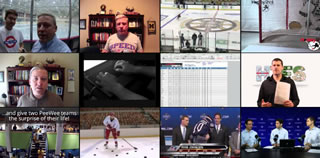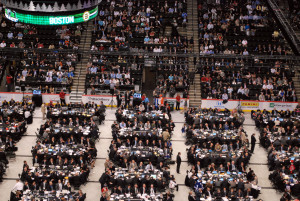Fantasy Hockey Definition:
Fantasy hockey is where players (fantasy GM’s) build a team that competes with other players (fantasy GM’s) who do the same, based on the statistics generated by professional hockey players or teams. The majority of fantasy hockey pools are based on the teams and players of the NHL.
If you plan to lay a beating on friends and workmates in this year’s fantasy hockey league, it’s time to get in game shape. These tips will help you exact revenge on that lucky know-nothing wiener who won it all last year, and spent the summer crowing about it.
Fantasy Hockey Advice
Fantasy hockey league tips that could make the difference in your pool this year.
If you are a fantasy hockey novice looking to set up a league, check out our suggested format for an entertaining, low maintenance fantasy hockey league.
Know Your Fantasy Hockey League
In the most basic hockey pool you simply draft ten skaters and add up their points. But some fantasy hockey leagues use every stat in the book: goalie numbers, plus-minus, penalty minutes, ice time, even players’ salaries. Your league might change rosters every week or ask you to slot players into a depth chart. The variations are endless. Read the rules and know what you’re getting yourself into.
Is He Healthy?
Nobody can anticipate a mid-season injury. But going into your draft, you need to know who’s healthy and who isn’t. Don’t disqualify all injured players – half a season from a scoring champ will outpoint 82 games from most third-liners – but check up on the latest injury reports. Remember also that last season’s wounded will post much better numbers if they are back to full health.
Fantasy Hockey News
Is He Signed?
It’s your turn to pick, and you are surprised to see that the kid who went on a scoring tear last season is still available. Could it be because he’s still sitting at home without a contract? Holdouts are rare in today’s NHL, and usually don’t extend beyond the first few weeks of the season. But the late start usually leads to a sub-par year.
Know Your History
Martin Lapointe had 27 goals and 57 points for Detroit in 2000-01. He had never come close to those numbers in seven previous seasons, and he never came close again. Sometimes a career year represents a genuine breakthrough. But over the long haul, most veterans return to their level. Which brings us to…
The 27 Rule
By the age of 27, most hockey players have found their level as point producers. The elite talents are the exception: Crosby or Ovechkin could ring up a career year at the age of 30 or 35. But the vast majority find their zone long before that. If a guy is 27 years old and still searching for the great leap forward, chances are it ain’t gonna happen.
Beware the Breakout
Every fall, any number of players are said to be due for “breakthrough” seasons. These seasons do happen – usually to players in their fourth or fifth years, occasionally to exceptional talents at a younger age. But it doesn’t happen as often as fantasy owners would like. In the early draft rounds, let someone else take a flyer on the young hotshot who is “primed to break out.” Sure, the kid might explode and make your rival look like a genius. But it’s a high-risk play. Use top picks for mature players.

Create or join an existing fantasy hockey team
Curb Your Optimism
Speaking of breakthroughs, they aren’t always as dramatic as people hope. A guy like Eric Staal, who jumped from 31 points to 101 points in a single season, is very rare. For most others, a 10 or 15-point improvement is a big move. The same goes for a player recovering from injury, coming off a great playoff performance, or joining talented new linemates. A step forward is more likely than a huge leap. It’s tempting to buy into best-case scenarios, but keep your expectations realistic.
It’s the Numbers, Not the Name
The best player is not always the best pick. In the real world, qualities like leadership, toughness, experience are celebrated. But none of that stuff matters in fantasy hockey. The toughest, meanest guy in hockey is a prime catch for any NHL team. But a fantasy owner is often better off picking a small, one-dimensional player who gets lots of power play time.
Beware the September Sensations
While reading a training camp report on your favorite team, you discover that Elmer Windsock, an obscure minor-leaguer, is practicing on the top line! If he keeps the job he could put up 50 points this year! Relax. Almost every team uses training camp to check out minor leaguers and rookies. By all means, keep track of training camp happenings, but don’t put too much stock in what you read. Elmer will likely be back in the minors by Hallowe’en.
Know Your Risk Tolerance
Given the choice between the high-risk/high-reward concussion case and the reliable guy who quietly puts up 45 points every year, I’ll take Mr. Reliable every time. Maybe you don’t agree, and prefer to take more chances. The point is, try to determine how adventurous you’re willing to be and stick with it.
Think Stability
The player list is thinning out, the draft is into its third hour, and all those 25-point guys are starting to look the same. Wake up! This is where a fantasy hockey league can be won or lost. If you don’t know who to pick, aim for a player in his late-20s or early-30s, playing for the same team and same coach as last season. Veterans who have settled into well-defined roles are a good bet for reliable production year after year.
Bonus Tip
This is a crapshoot, not a science. Do the homework, then relax and enjoy. Have a drink. Eat a chip. Take a couple of guys you enjoy watching. Use your last pick on your favorite goon. Chances are you’re going to lose anyway, no matter how well prepared you are. So enjoy yourself.
From Jamie Fitzpatrick
Follow on Twitter ☛ ☛ Follow @FitzpatJamie
Ice Hockey Series of Notes: Fantasy Hockey | Winnipeg Jets History | Winnipeg Hockey History
*

